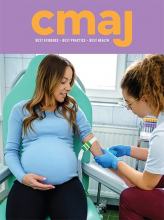Prepare outside the patient’s room: assign team roles, check equipment and review the airway strategy
Limit the number of in-room team members depending on the patient’s condition and delegate an outside-room “runner” to provide additional outside-room equipment and medications. The airway manager should be experienced enough to achieve greater than 85% first-pass success for endotracheal intubation.1 The airway strategy includes preoxygenation, positioning, endotracheal intubation and a clear plan for rescue oxygenation.2 Use a checklist to confirm in-room versus immediately available outside-room equipment and medications. Prepare all in-room materials in an airway box or go bag (Appendix 1, available at www.cmaj.ca/lookup/suppl/doi:10.1503/cmaj.200650/-/DC1). Patients with coronavirus disease 2019 (COVID-19) are “physiologically difficult.”2 Ensure that the patient’s code status is known and the crash cart is available.2
Don personal protective equipment (PPE) and cross-check team members3
During the severe acute respiratory syndrome epidemic, clinicians performing endotracheal intubation acquired infection at a 6-fold greater rate than their colleagues.4 Endotracheal intubation is a high-risk, aerosol-generating medical procedure that requires high-risk PPE, including an N95 respirator or equivalent.3 Speaking may become muffled and communication more difficult once PPE is donned.3
Videolaryngoscopy may have benefits over direct laryngoscopy
Videolaryngoscopy has a high first-pass success rate for experienced airway managers. A separate large screen allows the airway team to share laryngoscopy imaging and offers a greater team-to-airway distance.5
During intubation: anticipate rapid oxygen desaturation and associated emergencies
Use local protocols to guide intubation. Preoxygenate in a 30° head-up position. Ketamine may maintain cardiovascular stability compared with other induction agents.2 Have inotropes and vasopressors in line or immediately available. Use high-dose rocuronium (1.2–1.5 mg/kg) and ensure full neuromuscular blockade before attempting endotracheal intubation. 2 Owing to aerosol generation, avoid bag–valve–mask ventilation despite desaturation.2,4 Use a styleted endotracheal tube and avoid floppy bougies to minimize contamination. After intubation, place a viral filter on the endotracheal tube and inflate the endotracheal tube cuff to ensure no leak occurs with positive-pressure ventilation.2 Waveform capnography is invaluable for confirmation of endotracheal intubation, return of spontaneous circulation in cardiac arrest and circuit disconnection.2 Should circuit disconnection occur, clamp the endotracheal tube.2 Two emergencies may occur: “cannot intubate, cannot oxygenate” and cardiac arrest. Rescue oxygenation includes supraglottic device placement and endotracheal tube cricothyrotomy using a scalpel–bougie 6.0.
Removing PPE carries a high-risk of self-contamination
It is difficult to detect self-contamination.3 Use a doffing checklist, read each step aloud and remove PPE as directed by a spotter.3 Interruptions during this process should be minimized.
Footnotes
Competing interests: Laura Duggan is co-founder of The Airway App (www.airwaycollaboration.org/), a smartphone app for reporting outcomes of airway management, including for COVID-19. Gregory Bryson is the Deputy Editor-in-Chief of the Canadian Journal of Anesthesia for which he receives support from the Canadian Anesthesiologists’ Society. No other competing interests were declared.
This article has been peer reviewed.











